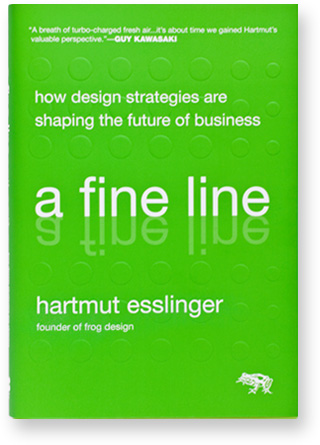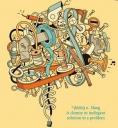The Master Frog Speaks!
Wednesday, September 9th, 2009
A small volume from a true design thinking master. For a video from the author, reviews and free chapters click here.

A small volume from a true design thinking master. For a video from the author, reviews and free chapters click here.
 The field of design psychology tries to understand why we make the design choices we do. What causes me to prefer and choose one interior design over another, one architectural/home style over another? The basic argument in the excellent book, Some Place Like Home: Using Design Psychology to Create Ideal Places, is that it is early childhood experiences in your father’s den, grandfather’s workshop and grandmothers kitchen that are the root cause of your design choices.
The field of design psychology tries to understand why we make the design choices we do. What causes me to prefer and choose one interior design over another, one architectural/home style over another? The basic argument in the excellent book, Some Place Like Home: Using Design Psychology to Create Ideal Places, is that it is early childhood experiences in your father’s den, grandfather’s workshop and grandmothers kitchen that are the root cause of your design choices.
Not only does this strongly determine consumer choice but also the decision making process of architects and other professional designers.
Talk about probing the mind of your customer! Of special interest to cognitive designers is the toolkit (see environmental autobiographies) and the emphasis on designing for positive change.
 In cognitive design we can model human-artifact interaction as a conversion of mental energy. We put mental effort into artifacts to use them and we get mental energy out in terms of how they make us think and feel. In this way interaction converts the mental work we must do to access functionality into the psychological lift – meaning, emotion and hardwired thinking – we get out of it.
In cognitive design we can model human-artifact interaction as a conversion of mental energy. We put mental effort into artifacts to use them and we get mental energy out in terms of how they make us think and feel. In this way interaction converts the mental work we must do to access functionality into the psychological lift – meaning, emotion and hardwired thinking – we get out of it.
So I am always on the look out for new insights into the nature of mental energy. Fortunately, there has been a lot to look at. With the discovery of mirror neurons there has been a small flood of studies that suggest we get/burn almost as much mental energy by observing a thing as we get from doing a thing. Consider the common experience of feeling exhausted after watching a emotionally-stirring movie. High engagement, high empathy observation burns/delivers nearly as much mental energy as the direct experience.
One recent scientific study that illustrates this is effect is, You Wear Me Out: The Vicarious Depletion of Self-Control. The researchers found a depletion in self control for those that observed others exerting it. They also found that reading about positive instance of self control (versus reading about failures to exert it) can increase the capacity for self control in subjects. If you don’t want to wade through the paper check out the excellent post, Being in Someone Else’s Head is Exhausting on the Neuronarrative.
 These findings suggest that our psychological distance from an event – thinking/reflecting, observing/emphasizing or participating/doing strongly determines the mental energy that flows from the experience. The relationship is not simply linear. Empathizing and doing for some things are nearly the same. Whereas the difference between thinking and doing can be opposite – one creating mental energy, the other burning it. This might explain why for example, vicarious experiences will produce behavior change (empathizing) when verbal persuasion does not (thinking). Further it may explain why some people with emotional intense jobs become remote – they increase their psychological distance to avoid the constant mental energy depletion associated with observing others in pain.
These findings suggest that our psychological distance from an event – thinking/reflecting, observing/emphasizing or participating/doing strongly determines the mental energy that flows from the experience. The relationship is not simply linear. Empathizing and doing for some things are nearly the same. Whereas the difference between thinking and doing can be opposite – one creating mental energy, the other burning it. This might explain why for example, vicarious experiences will produce behavior change (empathizing) when verbal persuasion does not (thinking). Further it may explain why some people with emotional intense jobs become remote – they increase their psychological distance to avoid the constant mental energy depletion associated with observing others in pain.
No matter, psychological distance and mental energy are fundamental to taking a systematic approach to cognitive design.
A major theme in cognitive design is that we don’t design things to fit how we think-and-feel very well. The lack of cognitive fit generates some serious problems and creates major innovation opportunities. But sometimes it can be extreme.
Many of the extreme cases (see above) are caused by the fact that my brain function evolves at a much slower rate than culture does. The brain of a hunter gatherer does not fit the cognitive task environment of a knowledge worker. The classic example is the inappropriateness of the fight-or-flight response we experience while disagreeing with our boss over a performance review.
Books, articles and posts that illustrate this extreme lack of cognitive fit abound. Two recent examples (thanks to Gina Farag) are given below.
An article in the New York Times, Yes Looks Do Matter, on how stereotyping has evolutionary roots:
”Eons ago, this capability was of life-and-death importance, and humans developed the ability to gauge other people within seconds.”
And an opinion piece in LiveScience, Losing It: Why Self Control is not Natural, claims lack of self control may have had an evolutionary advantage:
Apparently, it’s human nature to be out of control. Imagine our early ancestors roaming the savannah looking for food. They might bring down a gazelle, but that meat was probably not enough for some of the group. As soon as they wiped their mouths, those lacking self-control were probably off again on the hunt because they could not deny themselves anything.
 Of course many brain functions, the so-called higher brain functions, have evolved specifically for the purpose of adapting to the modern information age. Right? Well it seems even the nobel function of reason has come under the assault from an evolutionary perspective. Take a look at the book Kludge: The Haphazard Construction of the Human Mind as an example.
Of course many brain functions, the so-called higher brain functions, have evolved specifically for the purpose of adapting to the modern information age. Right? Well it seems even the nobel function of reason has come under the assault from an evolutionary perspective. Take a look at the book Kludge: The Haphazard Construction of the Human Mind as an example.
Flight-or-fight, self control, stereotyping and reasoning are powerful forces in society today. Yet in many ways, our hardwired approach to these is wildly out of step with the cognitive task demands of today’s culture. The effects are quite visibile – a tsunami of unwanted behaviors – discrimination, poor health choices, workplace violence.
Our technology-fueled culture will continue to advanced at an accelerate pace. It seems clear the only way our poor old slowly evolving brains will manage is via excellence in cognitive design.
 Designing to create a specific emotional reaction, frame of mind or series of mental states (i.e. an experience) is a key area for cognitive design. This is how you innovate, by moving your offering “up the value stream” from product to service to experience and ultimately to personal transformation for your customers. But does this make consumers happier?
Designing to create a specific emotional reaction, frame of mind or series of mental states (i.e. an experience) is a key area for cognitive design. This is how you innovate, by moving your offering “up the value stream” from product to service to experience and ultimately to personal transformation for your customers. But does this make consumers happier?
The PsyBlog reports on some interesting research that sheds light on the issue of material versus experiential purchase. Assuming you have $100 to spend, would you be happier investing it in an experience by say eating chicken at Medieval Times or buying clothing? The research found:
Experiential purchases tend to make us happier than material purchases, unless things go bad. If the purchase goes wrong, we are left a little less happy than if we would have bought something material.
There is a naturally symmetry to this. There is more “happiness value” (other things being equal) in an experience purchase and we feel the gain as well as the loss.
Seed and the Council on Competitiveness recently convened a diverse group to discuss the future of innovation. It is an interesting read. A sample for cognitive designers:
“Mullainathan said that this “last mile problem”—where people have all the information to act in an effective way but fail to do so—can be solved through innovations that adopt lessons from the social science of human behavior. As an example, Mullainathan used Clocky, a motorized alarm clock that jumps to the floor and rolls away while ringing, ensuring that users get out of bed to turn it off. An alarm clock has one piece of information to convey; adding wheels makes that information much more difficult to ignore. That kind of lateral thinking could be applied in many different contexts and at much larger scales, such as global health or poverty. “There are high returns to innovation in this kind of area because there are a lot of low hanging fruit—situations where behavior change can drive a huge return,” Mullainathan said.
 Just in case you wonder what Clocky looks like, I’ve include a photo. It is also interesting to note that “design” is an explicit part of the discussion on the future of innovation. Ten years ago that would not have been the case.
Just in case you wonder what Clocky looks like, I’ve include a photo. It is also interesting to note that “design” is an explicit part of the discussion on the future of innovation. Ten years ago that would not have been the case.
Seed magazine has an interesting opinion piece by Paola Antonelli, the senior curator of design at NY’s MOMA.
She touches on the sea changes in influence, educational centers and professional practices that are redrawing the once static map of design. Her basic thesis:
As the focus of design shifts from the production of finite goods to a practice of experimentation, ideas take precedence over products.

 An outstanding new book, Brain Landscape, argues that the time is ripe to develop paradigms that deeply integrate neuroscientific insights into architectural design practice and create classrooms that impact the cognitive processes of children, hospital rooms that impact the recovery rate of patients and work environments that improve white collar productivity as well as other spaces that favorably impact the brain.
An outstanding new book, Brain Landscape, argues that the time is ripe to develop paradigms that deeply integrate neuroscientific insights into architectural design practice and create classrooms that impact the cognitive processes of children, hospital rooms that impact the recovery rate of patients and work environments that improve white collar productivity as well as other spaces that favorably impact the brain.
The book is a treasure trove for the cognitive designer. The author, John Eberhard, provides grand vision:
“It seems likely that just as 19th-century physics underlay the development of 20th-century engineering applications, so neuroscience (combined with genetics) will become the basis for new applied science tools in the 21st century. In the next few decades it is likely that the fundamental aspects of neuroscience will become the domain of a new generation of applied social and behavioral scientists, engineers and architects.”
As well as a number of well-grounded hypotheses that are specific enough to guide design work:
“A child provided with a space that is appropriately scaled to his or her size will have an adjusted sense of time and space that leads to reduced stress, greater feelings of security, and increased competence.”
The book is a bit pricey but is available at a modest discount as a Kindle edition.
 Talk about cognitive design in the large! These research parks are city-sized environments designed to maximize the innovation and productivity of scientists and supporting knowledge workers. The idea is not only to provide a place to work but also a place to live, play and grow.
Talk about cognitive design in the large! These research parks are city-sized environments designed to maximize the innovation and productivity of scientists and supporting knowledge workers. The idea is not only to provide a place to work but also a place to live, play and grow.
There are a dozen or so worldwide, some old and many very new. For a whirlwind tour check out this slideshow or the entire BusinessWeek article, Research Parks for the Knowledge Economy.
 This year we will generate approximately 988 exabytes of digital information globally. That is 18 million times more than the information contained in all the books ever written. This goes far beyond the well-worn issue of information overload. It verges on the cognitively harmful even if ignored.
This year we will generate approximately 988 exabytes of digital information globally. That is 18 million times more than the information contained in all the books ever written. This goes far beyond the well-worn issue of information overload. It verges on the cognitively harmful even if ignored.
On this point an article in The Times, Warning: Brain Overload, argues the data tsunami dulls our capacity for empathy and wisdom. I read this as a clear mandate for the cognitive re-design of our personal and professional digital dataspaces.